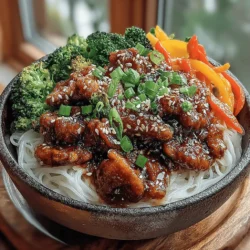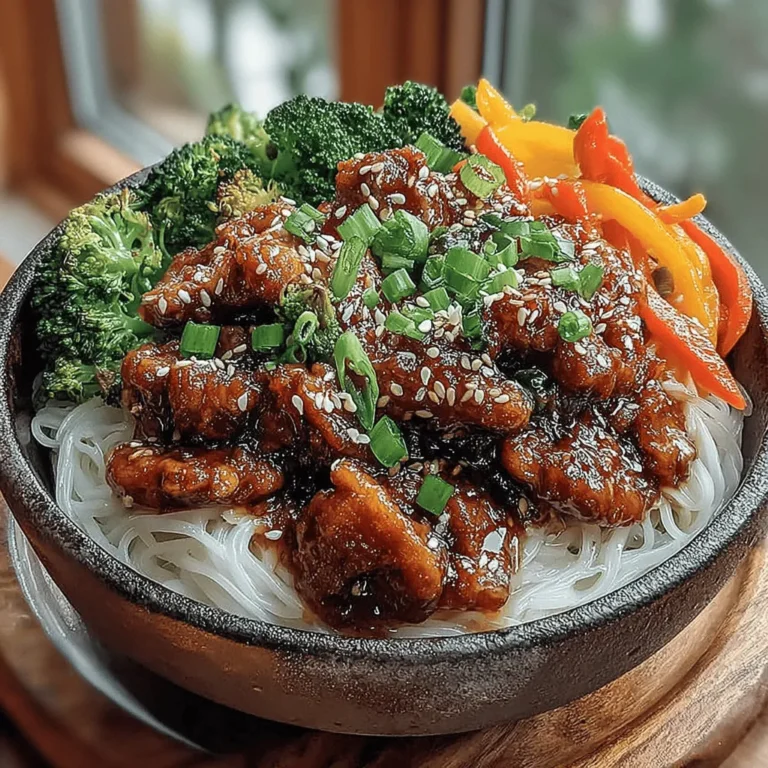Sticky Garlic Chicken & Noodle Bowls: A Flavorful Delight
In today’s fast-paced world, where time is often in short supply, the quest for quick yet delicious meals has become increasingly important. Among the myriad of culinary options available, Sticky Garlic Chicken & Noodle Bowls stand out as a perfect solution. This dish seamlessly combines tender chicken, vibrant vegetables, and flavorful noodles, all enveloped in a luscious sticky garlic sauce that tantalizes the taste buds. Not only is it quick to prepare, but it also offers a satisfying balance of flavors and textures, making it a beloved choice for busy families and culinary enthusiasts alike.
The Allure of Sticky Garlic Chicken & Noodle Bowls
Sticky Garlic Chicken & Noodle Bowls are a symphony of flavors that dance on your palate. The dish boasts a savory garlic base complemented by the sweetness of honey and the umami of soy sauce, resulting in a rich and sticky coating that clings to each piece of chicken. The tender chicken thighs, with their juicy texture, provide a hearty foundation, while the accompanying vegetables add a delightful crunch and freshness.
Culturally, this dish draws inspiration from various Asian cuisines, where stir-fried noodles and garlicky chicken are staples. Variations can be found in different countries, such as Chinese stir-fry, Japanese teriyaki chicken, and even Thai noodle dishes. Each culture brings its unique twist, but the essence of combining protein, vegetables, and noodles remains consistent, making this dish universally appealing.
From a nutritional standpoint, Sticky Garlic Chicken & Noodle Bowls pack a punch. Chicken thighs are not only flavorful but also provide essential protein needed for muscle repair and overall health. The vegetables—bell peppers, broccoli, and carrots—contribute vitamins A and C, fiber, and antioxidants, promoting a balanced diet. Noodles, depending on the type chosen, can offer carbohydrates for energy. Overall, this dish is not just a feast for the senses but also a wholesome meal option.
Ingredient Breakdown
To create the perfect Sticky Garlic Chicken & Noodle Bowls, it’s essential to understand the role of each ingredient in the dish.
– Chicken Thighs: Choosing chicken thighs over breasts is a game-changer. Thighs are richer in flavor and have a higher fat content, which helps keep the meat juicy and tender during cooking. This cut is less likely to dry out, making it ideal for quick stir-fry preparations.
– Marinade Ingredients: The marinade is the heart of the sticky garlic chicken. A combination of soy sauce, honey, rice vinegar, and minced garlic creates a harmonious blend of flavors. Soy sauce provides the necessary saltiness and depth, while honey adds a natural sweetness that balances the savory notes. Rice vinegar introduces a tangy acidity that brightens the overall flavor profile, and garlic infuses the dish with its aromatic essence.
– Vegetables: The inclusion of bell peppers, broccoli, and carrots not only adds color but also enhances the dish’s nutritional value. Bell peppers are rich in vitamin C and antioxidants, broccoli is a powerhouse of fiber and vitamins K and A, and carrots offer beta-carotene, converting to vitamin A in the body. Together, they provide a crunchy contrast to the tender chicken and noodles.
– Noodles: When it comes to noodles, you can choose between rice noodles and soba noodles. Rice noodles are light and soak up flavors beautifully, making them a popular choice in many Asian dishes. Soba noodles, made from buckwheat, are a great alternative for those seeking a gluten-free option while adding a nutty flavor.
– Sauce Components: The sauce not only coats the chicken but also enhances the overall flavor of the dish. Additional ingredients such as sesame oil or chili flakes can be introduced for an extra layer of complexity and heat, catering to different taste preferences.
Marinating the Chicken
Marination is a crucial step that cannot be overlooked. It allows the chicken to absorb all the flavors from the marinade, resulting in a mouthwatering dish. The process is simple yet effective, and here’s how to do it:
1. Prepare the Marinade: In a bowl, combine soy sauce, honey, rice vinegar, minced garlic, and any additional ingredients such as grated ginger or sesame oil. Stir until well combined.
2. Marinate the Chicken: Place the chicken thighs in a resealable plastic bag or a shallow dish. Pour the marinade over the chicken, ensuring each piece is well-coated. Seal the bag or cover the dish with plastic wrap.
3. Refrigerate: Allow the chicken to marinate for at least 30 minutes, though longer is better if time permits. Ideally, aim for 2-4 hours or even overnight to maximize flavor infusion.
4. Tips for Maximum Flavor: For deeper flavor, consider piercing the chicken thighs with a fork before marinating. This allows the marinade to penetrate more effectively. Additionally, remember to turn the chicken occasionally to ensure even marination.
Cooking the Noodles
While the chicken marinates, it’s time to prepare the noodles, which serve as the foundation of the dish. Here is a step-by-step guide to cooking rice or soba noodles:
1. Boil Water: Start by bringing a large pot of salted water to a rolling boil. The salt will help season the noodles as they cook.
2. Cook the Noodles: Depending on the type of noodles, cooking times may vary. Rice noodles typically take 3-5 minutes, while soba noodles may require 5-7 minutes. Consult the package instructions for specific cooking times.
3. Rinse the Noodles: Once cooked, drain the noodles in a colander and rinse them under cold water. This step is crucial as it prevents the noodles from becoming sticky and clumping together.
4. Alternative Noodle Options: For those with dietary preferences, consider using zucchini noodles, also known as “zoodles,” or whole wheat noodles. Both options provide unique textures and flavors while accommodating various diets.
With the chicken marinating and the noodles ready, you’re well on your way to creating a delightful meal that is not only quick to prepare but also bursting with flavor. In the next part of this article, we will delve into the cooking process of the chicken and vegetables, bringing this vibrant dish to life.
{{image_2}}
Stir-Frying Techniques for Perfect Chicken
Stir-frying is a cooking technique that involves cooking food quickly at high heat in a small amount of oil, typically in a wok or a large skillet. This method not only preserves the nutrients and flavors of the ingredients but also provides a delightful texture. When it comes to chicken, stir-frying creates a beautifully caramelized exterior while keeping the meat juicy and tender inside.
Tips for Achieving Perfect Caramelization on Chicken
To achieve that perfect caramelization on your chicken, follow these tips:
1. Pat Dry: Always pat the chicken pieces dry with paper towels before cooking. This helps to create a better sear and reduces steaming.
2. High Heat: Use high heat to encourage caramelization. This will help to lock in moisture and enhance the flavor of the chicken.
3. Don’t Overcrowd: If you add too many pieces of chicken to the pan at once, the temperature will drop, causing the chicken to steam rather than sear. Cook in batches if necessary.
4. Use Cornstarch: Tossing the chicken in a light coating of cornstarch before cooking can enhance the crispiness of the chicken and help with the caramelization process.
Importance of Cooking Chicken in Batches for Even Cooking
Cooking chicken in batches is crucial for achieving even cooking. When you overcrowd the pan, the chicken tends to release moisture, which leads to steaming rather than frying. By cooking in smaller portions, you allow the chicken to brown evenly and develop that signature sticky glaze. Aim to cook each batch for 4-5 minutes, or until golden brown, before transferring to a plate and repeating with the remaining chicken.
Sautéing Vegetables to Perfection
Sautéing vegetables is an essential component of any stir-fry, and doing it correctly can elevate your dish from average to extraordinary. The goal is to maintain the vibrant color and crunchy texture of the vegetables, which adds both flavor and visual appeal.
Best Practices for Stir-Frying Vegetables
1. Use High Heat: Just like with the chicken, high heat is essential for sautéing vegetables. This ensures that they cook quickly and retain their texture.
2. Cut Uniformly: Cut your vegetables into uniform sizes to ensure even cooking. Thinner pieces will cook faster while thicker ones take longer; try to maintain a consistent size for even results.
3. Add in Stages: Start with the vegetables that take longer to cook, such as bell peppers and carrots, and add quicker-cooking options like broccoli or snap peas later in the process. This will help maintain a balance of cooked and crisp vegetables.
Suggestions for Other Vegetables
Feel free to experiment with seasonal vegetables to add variety to your sticky garlic chicken and noodle bowls. Some excellent options include:
– Bell Peppers: They add sweetness and a pop of color.
– Zucchini: Quick to cook and adds a lovely texture.
– Snap Peas: Offer a delightful crunch and bright green color.
– Mushrooms: They absorb flavors beautifully and add earthiness to the dish.
– Spinach or Bok Choy: These leafy greens can be added at the end of cooking to wilt slightly and enhance the nutritional profile.
Combining Ingredients for Maximum Flavor
Once your chicken and vegetables are cooked to perfection, it’s time to combine them with the flavorful sauce that brings everything together. Timing is critical in this step to ensure that all components are harmoniously infused with the sticky garlic sauce.
Step-by-Step Guide to Bringing All Components Together
1. Remove Chicken and Vegetables: Once cooked, remove the chicken and vegetables from the pan and set them aside.
2. Prepare the Sauce: In the same pan, add garlic and ginger, sautéing for about 30 seconds until fragrant. Pour in the prepared sticky sauce mixture and bring it to a simmer.
3. Add Chicken and Vegetables: Return the cooked chicken and vegetables to the pan, tossing them in the sauce to coat evenly. Continue to cook for an additional 2-3 minutes to allow the flavors to meld.
4. Adjust Sauce Levels: If you prefer a saucier dish, feel free to add a splash of chicken broth or water to thin the sauce. For added richness, consider stirring in a bit of sesame oil at the end.
Importance of Timing in Combining Ingredients
The order in which you combine ingredients is vital to achieving optimal flavor absorption. By adding the chicken and vegetables back to the pan after the sauce has started to thicken, you ensure that they are perfectly coated without becoming mushy. This technique helps maintain the integrity of both the chicken and vegetables while maximizing flavor.
Serving Suggestions and Presentation Tips
Presentation is key to enhancing the dining experience, and with sticky garlic chicken and noodle bowls, there are numerous ways to make your dish visually appealing.
Ideas for Garnishing
– Green Onions: Thinly slice green onions for a fresh, vibrant garnish.
– Sesame Seeds: Toasted sesame seeds can add a nutty flavor and crunchy texture.
– Fresh Herbs: Consider adding fresh cilantro or basil for an aromatic touch.
Suggestions for Serving Bowls
Choosing the right bowl can elevate your dish. Consider using deep, wide bowls that allow for a generous serving of noodles, chicken, and vegetables. A contrasting color can make the vibrant dish pop even more.
Benefits of a Visually Appealing Dish
A well-presented dish does more than please the eye; it also enhances the overall dining experience. When food looks good, it sets the tone for a satisfying meal. Take a moment to arrange the chicken and vegetables artfully over the noodles, ensuring that each component is visible and inviting.
Nutritional Information
Understanding the nutritional value of your dish can help you make informed choices for your meals. Sticky garlic chicken and noodle bowls not only taste great but also provide a balanced mix of macronutrients.
Overview of Health Benefits
– Chicken: As a lean protein, chicken is rich in essential nutrients, including B vitamins and minerals like selenium and phosphorus, which support metabolism and immune function.
– Vegetables: Including a variety of vegetables adds vitamins, minerals, and antioxidants to your dish, contributing to overall health and well-being.
– Noodles: While they provide carbohydrates for energy, consider using whole grain or vegetable-based noodles for additional fiber and nutrients.
Caloric Breakdown and Dietary Considerations
A typical serving of sticky garlic chicken and noodle bowls contains approximately 500-600 calories, depending on portion sizes and specific ingredients used. This makes it a hearty meal suitable for lunch or dinner. To cater to various dietary needs, consider the following options:
– Gluten-Free: Use rice noodles or gluten-free pasta alternatives.
– Low-Carb: Substitute noodles with spiralized zucchini or cauliflower rice.
– Plant-Based: Replace chicken with tofu or tempeh for a delicious vegetarian version.
Conclusion
Sticky garlic chicken and noodle bowls are a delightful way to bring flavor and variety to your dinner table. The combination of perfectly stir-fried chicken and vibrant vegetables, all coated in a rich, sticky sauce, creates a meal that is not only satisfying but also easy to prepare.
By following the simple techniques outlined in this guide, you can master the art of stir-frying and create a dish that your family will love. Whether you’re cooking for a weeknight dinner or preparing for a gathering, these noodle bowls are sure to impress.
We encourage you to try making sticky garlic chicken and noodle bowls at home. There’s something truly satisfying about a homemade meal that brings everyone together, fostering connection and warmth around the dining table. Enjoy the process, and happy cooking!


